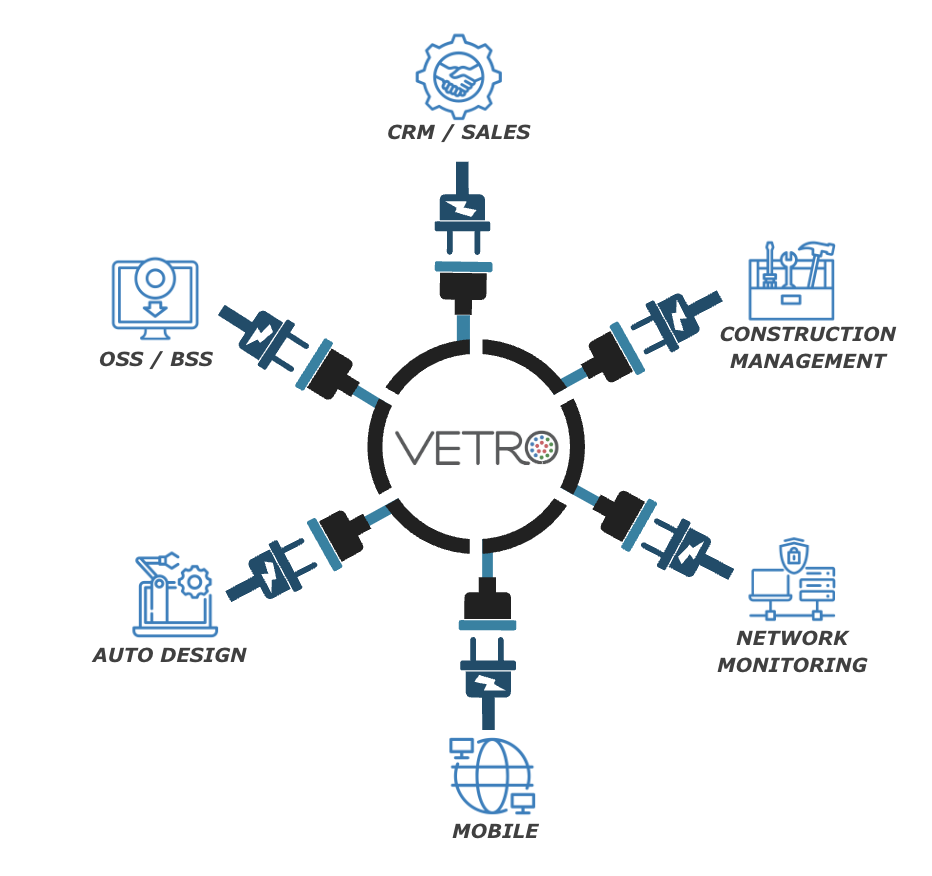What came first: the chicken or the egg?
This old riddle may be rote, but perhaps that’s because the metaphor has fundamental merit. The core of the chicken vs. egg debate is that the process of chickens laying eggs that hatch into new chickens has gone on too long for any of us to know the mechanics of how chickens and eggs came to be. There’s no way to answer the question: if the egg is dependent on the chicken to exist, and vice versa, then how did either of them come to exist in the first place?
Here at VETRO, we think about this difficulty – and helping our customers get around it – a lot.
In fiber management, and across applied data science solutions, dependencies can be one of the trickiest things to master – especially when it comes to entrenched or outdated business processes. Most of us have to keep moving to stay productive, competitive and cash-positive.
At VETRO, we know that planning, designing, deploying, and operating fiber networks is complex, and when companies are responsible for the entire network lifecycle, a reliable, consistent digital system of record becomes paramount.
While mature fiber operators may have many processes in place, an acquisition or expansion may drive the need to consider modern solutions for their projects that don’t disrupt the course of business. Meanwhile, newer operators may be looking at solutions across the full ecosystem of OSP software and considering dependencies and the order of operations in their business for the first time.
It’s not easy. In either situation, leadership may need to decide on solutions for Design/Engineering, Construction Management, Billing/Operating Software Systems, Network Monitoring, Sales and Marketing, and ongoing Fiber Management. ISPs need to understand how (and if) the chosen solutions will work seamlessly together to achieve desired business outcomes.
Determining the best option for your business and building a tech stack that meets those needs can be overwhelming. Even choosing where to start can be a challenge.

START WITH A FIBER MANAGEMENT SYSTEM OF RECORD
Let’s go back to the chicken and the egg. Apply that fabled debate to fiber network lifecycle management – everything is dependent on something else.
You can’t construct a network without having a viable design, so clearly network design software has to come first. However, it’s necessary to identify gaps in service and potential service areas before designing, and funding efforts are often informed by high level planning that may be predicated on demand data, federal or state maps, and even the terrain of potential markets.
Past the planning stages, construction activities are also inherently tied to your network map – that first need, a viable design, transforms into the “master copy” of your network; not only will construction software solutions require a real time connection to your design, but as-built changes must also be fed back to your map so that you always have an accurate representation of reality.
From there, the day-to-day management of your network begins – and every connection is predicated on the infrastructure that brings your network to life. Monetizing, optimizing and troubleshooting your network may fall to solutions like OSS/BSS, CRMs, and network and equipment monitoring, which all get critical infrastructure and engineering intel from your network map.
Where to begin? Many operators will have a combination of network lifecycles in play at any given time – for example, an ISP that has an existing network with an active service area, executing a greenfield FTTH project funded by a grant in the North, and an overbuild of copper infrastructure to the East.
In this scenario, a business leader might choose an investment in a CRM or provisioning system, as the idea of managing a slew of new customers in an outdated system seems overwhelming. Another decision-maker might prioritize workforce management, and yet another may have a great billing system in mind for a starting point to building a modern tech stack.
Across all of these inflection points, there is a unifying thread: every software system chosen will rely upon your master network map. Finding a system to plan, design, refine, analyze and visualize your network – whether it’s just in the idea stage or was built 20 years ago – is the smart first step.
Fiber Management fits that bill, and more. With VETRO, high level planning, applying for funding, streamlining permits and running analyses of potential cost and revenue segue directly into leading-edge design tools that make GIS easy and shave time off of common fiber design tasks.
From there, VETRO is built to share data, with turnkey construction outputs and supported integrations – so choosing systems like digital construction management, mobile data collection and project management software become a matter of filling in the blanks.
What it comes down to is this: if you aren’t sure where to start, a digital fiber management system is an ideal choice to support every phase of your network.
What is a digital Fiber Management System of Record?
A digital fiber management system of record is the blueprint for all things related to your network assets. The system of record will serve as your single source of information as you plan, design, deploy, and manage your fiber networks. Implementing an FMS reduces data channels and storage locations to a single hub, making your data more accessible and reducing time spent tracking down historical knowledge.
Why start with a digital Fiber Management System of Record?
A fiber management system of record, like VETRO FiberMap, is a centralized collaboration hub for operators, partners and vendors to stay in sync. Builders can get needed data in the field and feed it back automatically, and network funders and subscribers can stay constantly informed, building trust and accountability. Your FMS will last the lifetime of your networks. While adjacent solutions may come and go as needed, or will be gradually upgraded, your FMS remains constant, serving as the backbone of your organization. It becomes quite literally the digital home for your physical network.
Things to Look For in Your Fiber Management System of Record
There are a whole host of things to consider when choosing your FMS, many of which we’ve mentioned above. So, when push comes to shove, what are the four pillars a quality fiber management system needs to offer your organization?
1. Intuitive User Experience – VETRO’s slick, intuitive interface is quick to learn and easy to use, even without a GIS background.
2. Scalability – VETRO’s open system enables you to choose best-in-class adjacent solutions supporting specialty workflows over the life of your network, and the cloud native modern data platform can scale to any size network or organization.
3. Network visibility – the visibility of your network for the entire organization and stakeholders from day one.
4. Data integrity – accurate, consistent data stored, managed, and visualized in VETRO’s user-friendly, comprehensive platform from day one.
What’s Next?
Fortunately for engineers and OSP techs, they won’t be tasked with solving which came first between the chicken and the egg. And, while planning, designing, deploying, and operating fiber networks can be daunting, this problem has a clear solution. Your FMS should last the lifetime of your network, so choosing a robust, easy to use system of record first is key. With VETRO’s intuitive, comprehensive fiber management solution, you’ll have a centralized collaborative hub for every part of your organization. Why not start there?
To learn more about the VETRO FiberMap platform, contact us or request a full product demo.
